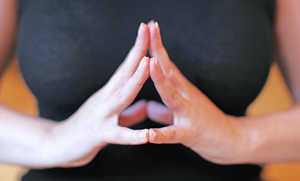Vrksasana (Tree Pose)
How to do it
Begin standing. Shift the weight of the body to your left foot. Bend your right knee, turn it out and place your right foot on the inside of your left leg. Gently press your foot into your leg and your leg into your foot. Lengthen up through the top of the head creating the sensation of lift through the entire body. Place your palms together in front of the chest.
Breathing in Vrksasana
Inhale: Lengthen upward and continue to turn your right knee out.
Exhale: Create a corset-like engagement around the waist while keeping your pelvis in place. Focus your gaze on a stable point at the eye level or below. Keep you shoulders relaxed.
Feet positions: You can place your foot on the inner thigh, slightly above the knee, slightly below the knee or near the ankle. The higher you put your foot, the more challenging it will be for the hip. Pick a foot position that will allow you to turn the bent knee out with more ease. Be sure not to place the foot on the inside of the knee joint (pressing sideways on your knee is never a good idea and can lead to injury).
Hand positions: The position of your arms/hands can add to your balance challenge or make it easier to balance.
- Keeping your arms out to the sides will make it easier to find equilibrium,
- Keeping your palms together in front of the chest is a bit more challenging, but might help with focus,
- Extending your arms all the way up with palms together is the most challenging version
You can also place your hands into Hakini mudra when you hold the pose. It promotes concentration, helps you focus and is supposed to facilitate cooperation between the right and left brain hemispheres.
Pose adaptations
Holding on to chair
Vrksasana: Holding on to chair gives physical and mental assurance to students who worry about their ability to balance. They can progress from keeping their hand on the chair to just lightly touching the chair with one finger as their confidence grows. Since they don’t have to worry about balance, students can focus on other elements of the pose: lengthening upwards along the spine and turning the knee out.
Shin on chair
Vrksasana: Shin on chair makes it easier to work with hip abduction in the pose. You can use chair as a reference point to feel where your leg is in space and also use it for stabilization purposes.
Knee press
Vrksasana: Knee press helps to prepare the leg for abduction by warming up the adductors and abductors. You can also experiment with turning your pelvis away from the bent knee and investigate how those two actions (hip abduction and pelvic position) relate to each other in this pose. This move can be done on its own, or in preparation to full Vrksasana.
Warm up
Vrksasana: Warm up is a good way to introduce your body to the balancing element of the pose, as well as the abduction element. When you extend your leg out, you get a much better sense of where your knee is pointing and how well your adductors and abductors cooperate in this pose.

